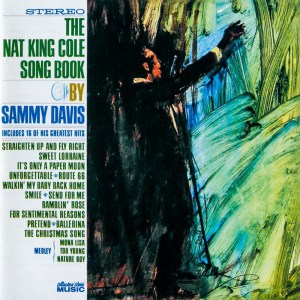More Sammy Davis, Jr.
Sammy Davis, Jr. Albums We’ve Reviewed

- A superb sounding original stereo copy with solid Double Plus (A++) sound or very close to it on both sides – exceptionally quiet vinyl too!
- Bigger and richer, with lovely Tubey Magic and breathy vocals, this Tri-Color Reprise pressing lets us hear Sammy at the peak of his powers performing some of Nat’s most memorable songs
- 4 Stars: “Alongside Cole’s collaborator, Billy May, and notable jazz arranger Claus Ogerman, Davis and company turned in one of the finest and most underrated efforts.”
This original Reprise pressing has the kind of Tubey Magical Midrange that modern records rarely even BEGIN to reproduce. Folks, that sound is gone and it sure isn’t showing signs of coming back. If you love hearing INTO a recording, actually being able to “see” the performers, and feeling as if you are sitting in the studio with Sammy Davis Jr., this is the record for you. It’s what vintage all analog recordings are known for — this sound.
If you exclusively play modern repressings of vintage recordings, I can say without fear of contradiction that you have never heard this kind of sound on vinyl. Old records have it — not often, and certainly not always — but maybe one out of a hundred new records do, and those are some pretty long odds.
What the best sides of The Nat King Cole Song Book from 1965 have to offer is not hard to hear:
- The biggest, most immediate staging in the largest acoustic space
- The most Tubey Magic, without which you have almost nothing. CDs give you clean and clear. Only the best vintage vinyl pressings offer the kind of Tubey Magic that was on the tapes in 1965
- Tight, note-like, rich, full-bodied bass, with the correct amount of weight down low
- Natural tonality in the midrange — with all the instruments having the correct timbre
- Transparency and resolution, critical to hearing into the three-dimensional space of the studio
No doubt there’s more but we hope that should do for now. Playing the record is the only way to hear all of the above.
What We’re Listening For on The Nat King Cole Song Book
- Energy for starters. What could be more important than the life of the music?
- The Big Sound comes next — wall to wall, lots of depth, huge space, three-dimensionality, all that sort of thing.
- Then transient information — fast, clear, sharp attacks for the piano, horns and drums, and crystal clear vocals, not the smear and thickness common to most LPs.
- Tight, note-like bass with clear fingering — which ties in with good transient information, as well as the issue of frequency extension further down.
- Next: transparency — the quality that allows you to hear deep into the soundfield, showing you the space and air around all the players.
- Then: presence and immediacy. The musicians aren’t “back there” somewhere, way behind the speakers. They’re front and center so you can hear everything carefully arranged by the accomplished composers, Edward William May Jr. and Claus Ogerman
- Extend the top and bottom and voila, you have The Real Thing — an honest to goodness Hot Stamper.
TRACK LISTING
Side One
Ramblin Rose
Unforgettable
Straighten Up And Fly Right
Pretend
Ballerina
It’s Only A Paper Moon
Smile
Side Two
Walkin’ My Baby Back Home
Route 66
For Sentimental Reasons
Send For Me
Sweet Lorraine
The Christmas Song
Medley: Mona Lisa/Too Young/Nature Boy
AMG Review
Alongside Cole’s collaborator, Billy May, and notable jazz arranger Claus Ogerman, Davis and company turned in one of the finest and most underrated efforts. The obvious affinity and respect the artist had for Cole dated back to Davis’ work with the Will Mastin Trio in the 1940s. No one can match Cole’s refined and sublime delivery however, Davis adds his own unique presence to a variety of pop ballads, early R&B tunes, and all seminal entries in Cole’s sizable catalog.
Special kudos deserved of the closing medley of “Mona Lisa,” “Too Young,” and Cole’s signature “Nature Boy.” Ogerman’s restrained instrumentation allows Davis room to make the melodies his own, while still very much retaining the warm, embracing, and above all gentle style that defined Nat King Cole.